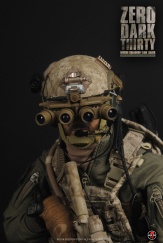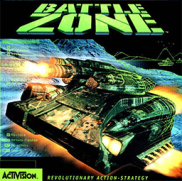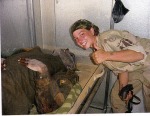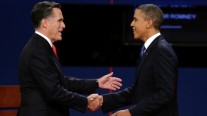http://madnessatthegates.wordpress.com/2013/05/29/barrys-blog-60-the-curse-of-the-fathers/
The Curse of the Fathers
What are the mythological roots of violence in the modern world? Can we speak about school shootings and the Boston bombing without also speaking about drones and targeted killings? Don’t lone gunmen and the agents of state violence enact our myths for all of us? Don’t we all have the same capacity for violence?
In 1964, Bob Dylan sang of these roots:
Oh God said to Abraham, "Kill me a son"
Abe says, "Man, you must be puttin' me on"
God say, "No." Abe say, "What?"
God say, "You can do what you want Abe, but
The next time you see me comin' you better run"
Well Abe says, "Where do you want this killin' done?"
God says, "Out on Highway 61".
Now the rowin' gambler he was very bored
He was tryin' to create a next world war
He found a promoter who nearly fell off the floor
He said I never engaged in this kind of thing before
But yes I think it can be very easily done
We'll just put some bleachers out in the sun
And have it on Highway 61.
A few images of masculinity have formed the base of our modern patriarchal consciousness in two main cultural streams, each of them 3-4,000 years old.
The Greeks:
Everything began with the Great Earth Goddess Gaia, who begat Ouranos (Heaven). They mated and produced the first generation of deities, the Titans.
The oldest storytellers inform us that Ouranos, first ruler of the universe, hated his children. He heard a prophecy that a son would overthrow him. So, as each of them was born, he pushed his children back into the body of Mother Earth. But one son, Kronos, escaped and hid. When he matured, he ambushed Ouranos while his parents were making love and castrated him. Some say that Gaia had actually given Kronos the sickle that he used. Others say that he threw his father’s severed testicles into the ocean, and that they became Aphrodite, the Goddess of Love.
Kronos, now the king of Heaven, freed his siblings, married his sister Rhea and produced the next generation of divine children who would eventually become the Olympian gods and goddesses we all know. However, fearing a similar prophecy, Kronos ate his children as each of them was born. Rhea hid the youngest, Zeus, and instead gave Kronos a stone wrapped in blankets, which he ate thinking he had disposed of the threat.
Eventually, Zeus found a way to release his siblings, and they waged a ten-year war against Kronos and the Titans, eventually defeating them and casting them down to the underworld, where they still live. Consider that “underworld” understood psychologically is the unconscious, both personal and cultural. Modern culture has cast the devouring father into our unconscious, because we cannot admit our capacity to destroy our own children.
Eventually, Zeus heard the same prophecy. After mating with Metis (Intelligence), he consumed her to prevent conception of yet another son who might overthrow him. This resulted in Athena’s birth from his forehead.
And so it went. Many other stories in the Greek tradition follow this pattern of the killing – and often the eating – of innocent children.
Over many centuries, Kronos’ Roman equivalent Saturn eventually came to personify Father Time, which devours all things.
For 3,000 years, or 150 generations, Ouranos and Kronos, the original patriarchs, have been our models for two extreme patterns of fathering. Ouranos is the classic absent father: completely gone, or if in the household, he is uninvolved, unavailable, hidden behind the newspaper, brushing off needy children with the phrase, “Ask your mother.”
By contrast, Kronos is overly involved: tyrannical, judgmental, colonial, abusive, predatory, rapacious, murderous. Ouranos neglects the children, but Kronos kills their creativity with his unreasonable expectations. Many works of art have depicted Kronos, but the most famous is Goya’s Saturn Devouring One of His Sons.

Jay Scott Morgan describes this masterpiece:
Cover the right side of the face, and we see a Titan caught in the act, defying anyone to stop him, the bulging left eye staring wildly at some unseen witness to his savagery, his piratical coarseness heightened by the sharp vertical lines of the eyebrow, crossed like the stitches of a scar. Cover his left eye, and we are confronted by a being in pain, the dark pupil gazing down in horror at his own uncontrolled murderousness, the eyebrow curved upwards like an inverted question mark, as if he were asking, “Why am I compelled to do this?”
Kronos is the fabric of our daily lives. Benjamin Franklin equated Time, the ancient god, with money, the new one. Jonathan Swift’s Gulliver told the Lilliputians that his watch determined every action of his life. They concluded that it must be his god. Now we carry Time’s temple with us continually, on our wrists.
Ouranos and Kronos are ancient images of archetypal patterns. As such, they are extreme models of fathering. Few fathers express only one of them purely; rather, most of us seem to share aspects of both patterns.
Among men of our generation, Ouranos – the absent father – is more prevalent. But for most men throughout Western history, Kronos – the devouring father – has been a more powerful determinant of social patterns.
As different as these images are from each other, most images of fathering within patriarchy have two things in common. First, they are narcissists who won’t acknowledge the needs or even the subjectivity of their children. Second, by refusing to share life’s abundance, they encourage sibling rivalry and establish the belief that all good things, from food to love to petroleum, are scarce and must be earned.
These mythic figures profoundly influence masculine psychology as well as the course of modern history. The connection is simple: if masculinity in a society is formed in such a narrow range, then power elites will always manipulate men toward the expression of power in war and mass conformism. In such a world, most men will choose power over love.
The Hebrews:
The second major mythic tradition comes from Hebrew myth, where Jehovah shares elements of both Ouranos and Kronos. He is distant and unknowable, yet jealous and vindictive. He regularly tests the loyalty of the Israelites, and his relationship with them is marked by the constant threat of sacrifice.
When Ham accidentally discovered his father Noah naked, Noah cursed Canaan, one of Ham’s sons, and all of his descendants. Noah’s other sons escaped the curse by covering their eyes so as not to see him naked. Assenting to Ham’s curse, they gained Noah’s approval. Indeed, biblical brothers often fight each other (Cain/Abel, Jacob/Esau, Joseph and his brothers, Amnon/Absolom) instead of their fathers. Unlike the Greeks, the Hebrew patriarchs seemed to deliberately promote sibling rivalry, knowing that if brothers were to love each other, they might unite and overthrow the fathers.
Child sacrifice is a common Old Testament theme. Jehovah accused the Israelites: “… you slaughtered my children and presented them as offerings!” Like the pagans, they “shed innocent blood, even the blood of their sons and daughters,” wrote the Psalmist, “whom they sacrificed unto the altars of Canaan…” When Phineas murdered a Hebrew for sleeping with a pagan woman (he murdered her as well), God was pleased: “Phineas turned my wrath away…he was zealous for my sake, so that I consumed not the children of Israel in my jealousy.” Lot offered Sodom his two virgin daughters to “do ye to them as is good in your eyes.”
Most significantly, Abraham – father of Judeo-Christian-Moslem monotheism – was willing to sacrifice Isaac to prove his loyalty to God. The “Binding of Isaac” is called the Aqedah in Hebrew and the Dhabih or "Slaughter" in Arabic, and Jews, Christians and Muslims have debated its significance for hundreds of years. (see Abraham's Curse: The Roots of Violence in Judaism, Christianity, and Islam by Bruce Chilton).
Chilton writes, “Different versions of Genesis 22 circulated in an immensely varied tradition…in Rabbinic sources and – with key changes – in both Christian and Islamic texts.” In many of these later versions, Isaac was indeed sacrificed.
I invite you to consider symbolic interpretations of this story. But for our purposes, its meaning is clear: whatever Abraham did or didn’t do, he was willing to murder his son to appease the father god, and men have taken this model quite literally for many hundreds of years. “Uniquely among the religions of the world,” writes Chilton, “the three that center on Abraham have made the willingness to offer the lives of children – an action they all symbolize with versions of the Aqedah – a central virtue for the faithful as a whole.”
Generally, however, the patriarchs couldn’t openly admit that men – at least Hebrew men – had such barbaric potential, so they projected child sacrifice onto the gods – such as Moloch – of other people. Only other people – the Other – would do this.
Later, Christians learned that “God so loved the world that he gave his one and only Son.” There may very well be convincing symbolic explanations for this quote, but we are talking about how a culture became so “demythologized” (in Joseph Campbell’s terms) that most people have no alternative but to take their myths quite literally.
As Jesus hung in terrible agony on the cross, God confirmed the most fundamental theme of Western culture when he abandoned his son. When Jesus asked, “Father, why have you forsaken me?” he was actually quoting from Psalm 22. Written1,000 years before, it acknowledged the centuries of abuse, betrayal and the profound depression – or unquenchable rage – they produce. Whether Hebrew or Greek, patriarchs have repeatedly slaughtered the innocent.
So where does Jesus, the god of loving compassion, fit into this mythic tradition? Three days after his death, the tomb is empty. Jesus has gone to the invisible world to be with his father. But what of those he leaves behind? From humanity’s perspective, going to Heaven to join the father god is, simply, like Ouranos, to leave. By doing so, Jesus contributes to the narrow modeling of fatherhood that I’ve been describing. This is the model – one followed by millions of modern fathers: when things get difficult – in relationship, in community, in dealing with women or children, or with any strong emotions, it is better to leave. Psychologically speaking, to stay is to remain vulnerable to the fear that we associate with emotional commitment. So we leave physically, or even if we stay, we leave emotionally, through substance abuse or workaholism.
This default mode of leaving when things get difficult is entirely consistent with the pattern of the American hero that I have described in other writings. This hero, in hundreds of incarnations through the centuries, generally leaves the community once his work of violent redemption has been completed.
Two thousand years later, at most American funerals, mourners are reassured that the deceased has gone to “a better place,” he or she has gone to “be with God.”
A quick digression: Years after the National Guard shot four students dead at Kent State University (in 1970), a memorial to the students was commissioned. The job went to the well-known sculptor George Segal. But the university rejected his offer, a representation of Abraham about to murder Isaac.

It wasn’t always like this. For thousands of years, tribal initiation rituals had symbolically killed the boys in order to turn them into men. However, when young men go to war and enact the myths of self-sacrifice for the approval of their fathers, symbolic death becomes literal death. In their unconscious longing for initiation, they attempt to defeat Father Time through heroism and self-sacrifice. Psychologist Robert Moore writes, “There is no way to understand the attractiveness of war without understanding the unconscious seduction of the archetype of initiation.”
The myths I’ve described are absolutely central to Western consciousness. They describe basic father-son relationships and indicate how long it has been since initiation rituals broke down. For at least three millennia, patriarchs have conducted pseudo-initiations, feeding their sons into the infinite maw of violence. Such rituals always include both a threat and a deal: Submit to our authority or else. Sacrifice your individuality and your emotions. In exchange you may dominate your women and children.
Indeed, it was their great genius – and primordial crime – to extend child-sacrifice from the family to the state. Boys eventually were forced to participate in the sacrifice. No longer surrendering to symbolic death, they learned to, in a sense, overcome death by inflicting it on others.
Ultimately, sacrifice – dying for the cause – became as important as killing for the cause. Martyrdom became an ethical virtue that every believer must be prepared to emulate. Wilfred Owen’s poem Dulce et Decorum Est that many of you know speaks to a military motto that goes back to the Romans (“It is a sweet and noble thing to die for your country”). Owens wrote – and died – during World War One, which caused 37 million casualties, or 25,000 casualties per day, every day, for four years.
Dulce Et Decorum Est
Bent double, like old beggars under sacks,
Knock-kneed, coughing like hags, we cursed through sludge,
Till on the haunting flares we turned our backs
And towards our distant rest began to trudge.
Men marched asleep. Many had lost their boots
But limped on, blood-shod. All went lame; all blind;
Drunk with fatigue; deaf even to the hoots
Of gas shells dropping softly behind.
GAS! Gas! Quick, boys! -- An ecstasy of fumbling,
Fitting the clumsy helmets just in time;
But someone still was yelling out and stumbling
And floundering like a man in fire or lime.
Dim, through the misty panes and thick green light
As under a green sea, I saw him drowning.
In all my dreams, before my helpless sight,
He plunges at me, guttering, choking, drowning.
If in some smothering dreams you too could pace
Behind the wagon that we flung him in,
And watch the white eyes writhing in his face,
His hanging face, like a devil's sick of sin;
If you could hear, at every jolt, the blood
Come gargling from the froth-corrupted lungs,
Obscene as cancer, bitter as the cud
Of vile, incurable sores on innocent tongues,
My friend, you would not tell with such high zest
To children ardent for some desperate glory,
The old Lie: Dulce et decorum est
Pro patria mori.
War allows old men to project their ambivalence toward their own unhealed and uninitiated inner selves onto actual youths. It is deferred infanticide, the revenge of the old upon the young.
In another great poem by Owen speaks more directly to the mythic roots of the issue:
Parable of the Old Man and the Young
So Abram rose, and clave the wood, and went,
And took the fire with him, and a knife.
And as they sojourned both of them together,
Isaac the first-born spake and said, My Father,
Behold the preparations, fire and iron,
But where the lamb for this burnt-offering?
Then Abram bound the youth with belts and straps,
and builded parapets and trenches there,
And stretchèd forth the knife to slay his son.
When lo! an angel called him out of heaven,
Saying, Lay not thy hand upon the lad,
Neither do anything to him. Behold,
A ram, caught in a thicket by its horns;
Offer the Ram of Pride instead of him.
But the old man would not so, but slew his son,
And half the seed of Europe, one by one.
These are very practical issues. Men’s groups often wrestle with such questions:
-- Was your father more a Kronos type or an Ouranos?
-- What type of father are you?
-- How was the curse cast? What is the image? Where do you hold it in your body?
-- How does it affect your sense of masculinity and your relationships?
-- Was your father under the same curse?
-- Do you cast it on others? On yourself?
-- How is it activated in you?
-- How do you break the curse? How do you fail?
Killing the Children Throughout History
Yet don’t we idealize our children? Parents commonly deny their own needs so that “the children” might have a better future, and government demonizes and punishes those suspected of harming them. We go to war so the children may be free, and so on.
We love children because the archetypal child symbolizes rebirth, transformation and innocence. Christ said that to enter “the kingdom” one must be as innocent as those whose minds and bodies are still undivided by civilization. So the child personifies the lost unity adults long for – which most adults, however, cannot recover without being psychologically “dismembered.” Thus children also evoke the suffering to be endured on the road back to wholeness, and the grief over what we have lost. Consequently, many adults are compelled to destroy that image, to remove it from consciousness and replace it with idealization.
Why else would we bloviate about family values and threats to “the children” while gleefully destroying social programs proven to keep families together? Why else would Americans even debate the notion of punishing children simply because their parents are poor?
The mythological perspective tells us that these things can only happen in a society that is deeply ambivalent about its own children. “Some things,” writes psychologist David Bakan, “are simply too terrible to think about if one believes them. Thus one does not believe them in order to make it possible to think about them.” Idealization is the way we keep the secret that our culture is built upon sacrifice of our actual children.
Lloyd de Mause begins his survey of the vast literature on European child-raising: “The history of childhood is a nightmare from which we have only recently begun to awake.” Christians long believed that children were inherently perverse: “The new-born babe is full of the stains and pollution of sin, which it inherits from our first parents through our loins.” They required extreme discipline and early baptism, which used to include actual exorcism of the Devil. Initiation rites became further literalized in child abuse, with customs ranging from tight swaddling and steel collars to foot binding, genital circumcision and rape.
There is considerable evidence of the literal killing of both illegitimate children (at least as late as the 19th century) and legitimate ones, especially girls, in Europe. As a result, there was a large imbalance of males over females well into the Middle Ages. Physical and sexual abuse was so common that most children born prior to the 18th century were what would today be termed “battered children.” However, the medical syndrome itself didn’t arise among doctors until 1962, when regular use of x-rays revealed widespread multiple fractures in the limbs of small children who were too young to complain verbally.
What kind of people do these patterns produce? De Mause argues that war and genocide do “…not occur in the absence of widespread early abuse and neglect,” that nations with particularly abusive and punitive childrearing practices emphasize military solutions and state violence in resolving social conflicts. Furthermore, “Children brought up with love and respect simply do not scapegoat…”
“Americans,” writes James Hillman, “love the idea of childhood no matter how brutal or vacuous their actual childhoods may have been.” We idealize childhood because our actual childhood did not serve its purpose, which was to provide a container of welcome into the world that would be the necessary precursor for initiation into mature adulthood. Without such preparation, we assume that alienation is the true nature of maturity. And if humans have no true animating spark, neither does the natural world. So generation after generation of young men will be motivated to project their own need for rebirth onto the world and set out to literally destroy it. This is how Patriarchy perpetuates itself. In each generation, millions of abused children identify with their adult oppressors and become violent perpetrators themselves. In a demythologized world, they have no choice but to act out the myths of the killing of the children on a massive scale.















